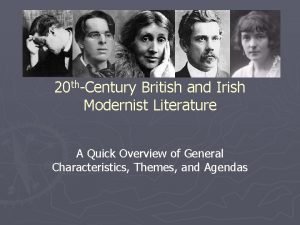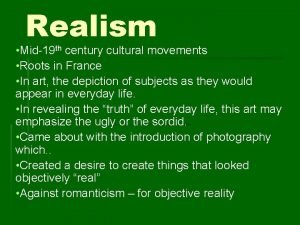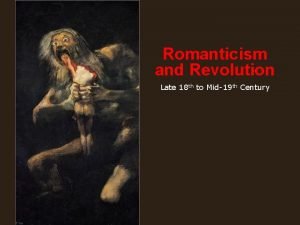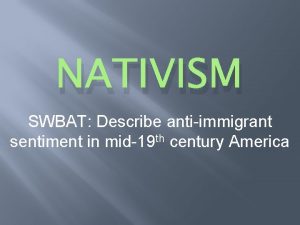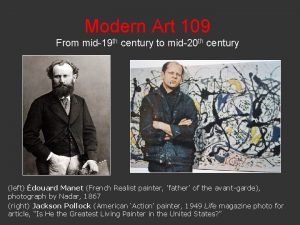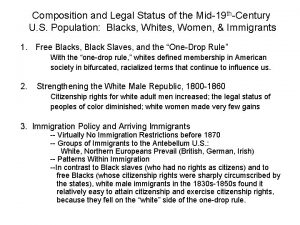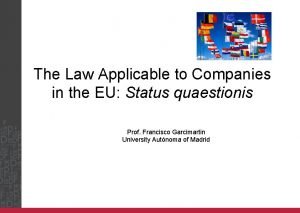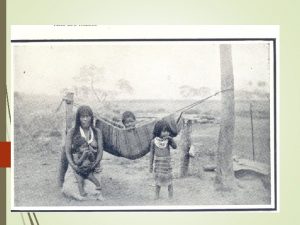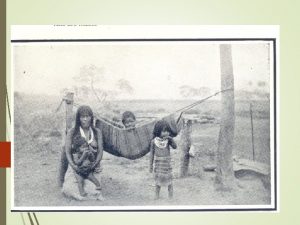Composition and Legal Status of the Mid19 thCentury













- Slides: 13

Composition and Legal Status of the Mid-19 th-Century U. S. Population: Blacks, Whites, Women, & Immigrants 1. Free Blacks, Black Slaves, and the “One-Drop Rule” With the “one-drop rule, ” whites defined membership in American society in bifurcated, racialized terms that continue to influence us. 2. Strengthening the White Male Republic, 1800 -1860 Citizenship rights for white adult men increased; the legal status of peoples of color diminished; white women made very few gains 3. Immigration Policy and Arriving Immigrants -- Virtually No Immigration Restrictions before 1870 -- Groups of Immigrants to the Antebellum U. S. : White, Northern Europeans Prevail (British, German, Irish) -- Patterns Within Immigration --In contrast to Black slaves (who had no rights as citizens) and to free Blacks (whose citizenship rights were sharply circumscribed by the states), white male immigrants in the 1830 s-1850 s found it relatively easy to attain citizenship and exercise citizenship rights, because they fell on the “white” side of the one-drop rule.

Thomas Fitzgerald (c. 1808 -1879), Sarah Ann Burton Fitzgerald (c. 1818 -c. 1889), and their daughter Agnes Fitzgerald (18581920). Thomas and Sarah Ann were Robert Fitzgerald’s parents.

Cornelia Smith (1844 -1924) Robert Fitzgerald (1840 -1919), photo taken in 1863 during his naval service.

The family of Robert and Cornelia Fitzgerald. On the left, Cornelia, Robert, and Roberta in the front row, and Pauline, Agnes (Pauli Murray’s mother), and Sarah Ann in the back, On the right, the five daughters of Robert and Cornelia Fitzgerald: Roberta, Pauline, Agnes, Sarah Ann, and Maria.

The Legal Status of “Free Blacks”—Not really all that “free” Growth in the Number of “Free Blacks” 60, 000 in 1790; 488, 000 in 1860 (260, 000 in the South) “Free Blacks” Often the Result of Interracial Sex In 1860, 10% of the slave population was of mixed ancestry; In 1860, 41% of southern “Free Blacks” were of mixed ancestry The “One-Drop” Rule: “One drop of Black blood” (i. e. one known African-descended ancestor) made one Black. This was a pseudo-scientific means of delineating race —not only for Blacks but also for Whites. It meant that, although actual ancestries and racial identities could be quite complex and fluid, the law drew a very firm line between a “pure” White race and a polyglot Black race.

“Justification” of the “One-Drop” Rule “In every part of the United States, there is a broad and impassable line of demarcation between every man who has one drop of African blood in his veins, and every other class in the community. The habits, the feelings, all the prejudices of society—prejudices which neither refinement, nor argument, nor education, nor religion itself can subdue— mark the people of colour, whether bond or free, as the subjects of a degradation inevitable and incurable. The African in this country belongs by birth to the lowest station in society; and from that station he can never rise, be his talents, his enterprise, his virtues what they may. ” Connecticut Colonization Society, 1828

THE AMERICAN SOCIAL AND LEGAL HIERARCHY, 1800 -1860 Privileges and rights for white men grew, while those for non-whites decreased. White Men with Property: Remained first-class citizens White Men without Property: Mostly first-class citizens--by 1860, native-born white men without property could vote in all but one state White Immigrant Men: Eligible to become citizens fairly soon; no more property requirement; arriving in increasing numbers between 1830 and 1860 White Women and Children: Citizens, but primarily second class, with fathers/husbands legally speaking and acting on their behalf. In the North, middle-class women carved out a growing public role within a “woman’s sphere” and the suffrage movement began. But few practical legal gains. Immigrant women took on the citizenship of their husbands “Free” Blacks: Citizenship status depended upon where they resided. Southern states steadily reduced their rights, 1800 -1860, and even many northern states backed away from recognizing a limited sets of rights for them as happened 1776 -1800. Native Americans: Some “founding fathers” (especially Jefferson) had thought that Native Americans could assimilate. But between 1800 and 1860 the white leaders of the U. S. actually limited Natives’ rights even more than before. Even “assimilated” Indians found their rights circumscribed. Enslaved Black Men and Women (Property, not citizens): Southern states in 18001860 made it harder to terminate slavery and liberate individual slaves.

Castle Garden, New York City, 1855 -1890

Ellis Island opened between 1890 and 1892, when the U. S. government finally took charge of processing immigrants. The photo is from 1978.

Numbers of Immigrants to U. S. before 1870 1820 s: 150, 000 1830 s: 600, 000 1840 s: 1, 700, 000 1850 s: 2, 600, 000 1860 s: 2, 300, 000 The great majority of these came from Europe, although Asians (esp. Chinese) began arriving during the 1850 s. Between 1820 and 1860, roughly 5 million immigrants arrived in the U. S. — more than the country’s 1790 total population of just less than 4 million.

European Sources of Immigration to the U. S. , 1820 -1860 (% figure refers to percentage of entire immigration) British German Irish 54, 338 (35. 8%) %B+G+I 1820 s 27, 489 (18. 1%) 7, 729 (5. 1%) 59% 1830 s 75, 810 (12. 7%) 152, 454 (25. 5%) 207, 381 (34. 6%) 72. 8% 1840 s 267, 044 (15. 6%) 434, 626 (25. 4%) 780, 719 (45. 6%) 86. 6% 1850 s 423, 974 (16. 3%) 951, 667 (36. 6%) 914, 119 (35. 2%) 88. 1% 1860 s 606, 896 (26. 2%) 787, 468 (34. 0%) 435, 778 (18. 8%) 79%

Anti-Irish sentiment in the U. S. was substantial during the 1840 s and 1850 s. Cartoonists portrayed emigrants from Ireland as sub-human, degraded, and alcoholic. The Irish were also characterized as incapable of assimilation, as threats to order and stability, and as radical. Protestant Americans also complained about their Catholicism.

THE AMERICAN SOCIAL AND LEGAL HIERARCHY, 1776 -1783 (from Oct. 12 lecture—these years saw the relative growth of citizenship rights) White Men with Property: Mostly first-class citizens, and the group of people in charge of government White Men without Property: Citizens, but with limited rights Recently arrived white immigrant men: Eligible to become citizens over time White Women and Children: Citizens, but primarily second class, with fathers and husbands legally speaking and acting on their behalf “Free” Blacks: Citizenship status depended upon where they reside, with southern colonies/states greatly restricting rights and even northern colonies/states usually limiting rights in many ways Native Americans: Not generally considered citizens of U. S. ; at times associated with Indian “nations” for diplomatic and military purposes—but those purposes very seldom anticipated inclusion within U. S. society and politics, unless Native Americans assimilated to white society Enslaved Black Men and Women: Property, not citizens
